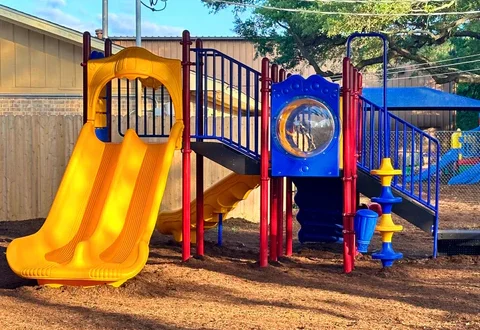Introduce yourself to more than just fun and games.
Outsiders may think that Play is just something children do to pass the time. They might run, build, pretend, or draw. Play is a serious way to learn.
Play is a way for young children to explore the world, learn new ideas, solve puzzles, and form relationships. Play is not a luxury in childcare settings, whether it’s at home, a daycare, or a preschool. It is that the learning.
Albert Einstein: “Playing is the highest form research.”
1. What is Play-Based Learning (PBL)?
Play-based education involves activities guided by the child’s imagination and curiosity, with some adult structure or support. The child is in control, deciding what to do, how to do it, and which rules to follow.
Core Elements of Play-Based Learning
- Child-directed: the child selects the activity
- Active engagement: Involves movement, touch, exploration
- A playful and creative. Encourages surprise, laughter and curiosity
- Process-focused: the value of doing is not in winning or finishing.
- Open-ended: There is no “right” way of playing.
2. The Brain on Play and Why it Matters to Development
Children’s brains are active when they play. The brain forms neural connections that:
- Language development
- Problem-solving and reasoning
- Emotional regulation
- Gross and fine motor skills
- Creativity, imagination
- Memory
Playing helps children internalize and process what they have learned.
3. The Different Types of Play and the Lessons Each Teaches
Different types of Play develop other skills, which are included in a well-rounded childcare program.
1. Physical Play
Building coordination, strength and confidence through running, climbing, dancing, throwing, or throwing
2. Constructive Play
Building with LEGO, recyclables or blocks
Teaches planning, problem-solving, and spatial awareness
3. Dramatic Play (Pretend Play)
Dressing up, house games, superheroes, cooking in toy kitchen
Encourages empathy, role-taking, language and imagination
4. Social Play
Team building, board games, group storytelling
Promotes cooperation, negotiation and rule-following
5. Quiet Play (Solitary Play)
Reading, drawing, sorting, working independently
Encourages focus, creativity, and emotional self-regulation
4. Play in Childcare Settings: What it Should Look Like
Play is a powerful tool for learning, and quality childcare centres structure their days around it.
Search for:
- Indoor and outdoor playtime
- Play-based zones or centres (e.g. reading corner, block area. dramatic play station).
- Time for free Play where children can choose their activity
- A teacher-guided game that promotes skills-building.
- Safe and stimulating materials – open-ended toys (art supplies), sand/water table, etc.
Rich play environments are not filled with electronic toys but rather simple materials that encourage creativity.
5. What role do caregivers play in supporting Play?
Adults are more than just supervisors. They are playmates as well as facilitators of learning.
What caregivers should do:
- Be aware of your child’s needs and interests
- Play for longer by asking open-ended questions (“What will happen next?” “Why did I choose this block?”
- Model Behavior without Taking Over the Game
- Group play for social skills
- Encourage risk-taking in safe boundaries to encourage independence
It is not the goal to direct a play but to gently guide it with respect.
6. Use Play to Teach Core Ideas
Without a single worksheet, Play can be used to introduce and reinforce concepts for early learning.
Play is a great way for children to learn:
- Math: Counting blocks, matching shapes, measuring sand
- Science – Observing plants and water, experimenting with magnets
- Literacy: Stories, puppet shows, and recognizing letters on labels
- Social Studies: Explore family roles, community workers, holiday traditions
- Art & Music: Expression of emotions, patterns, rhythm, and sound
When children are having fun and are emotionally engaged, they retain more information.
7. The dangers of over-scheduling or under-playing
Play is often sacrificed to early math or reading instruction. This can be counterproductive, according to research.
Too Little Play Can Be Dangerous
- Stress and anxiety increases
- Attention spans are shorter
- Lack of creativity and problem-solving ability
- Poorer social development
- Learning can be boring and demotivating.
Children are not tiny adults. Children need imaginative, unstructured Play, not constant testing or performance.
8. Encourage Play at Home
With a few simple items and a lot of imagination, parents and caregivers can create an “active” home environment.
You can play at home with these ideas:
- Build a fort using blankets and pillows
- Make a “busy bin” using rice, cups and spoons
- Create an art station using paper, crayons and stickers
- Pretend cooking with kitchen tools
- Dance party with scarves and music
- Dress up or act out bedtime tales
Both are equally important.
9. Playing builds a better future
Playing with children increases their chances of becoming:
- Curious Learners
- Team players who work together
- Emotionally healthy people
- Problem-solvers who are creative
- Confident communicators
Playing builds life and school skills.
Conclusion: Play is not optional — it’s essential
Play is the way children discover and connect. Deal with and grow. Every laugh, every mess and every story is a learning opportunity.
Supporting children’s Play is one of the best things you can do, whether you are a parent or teacher.





